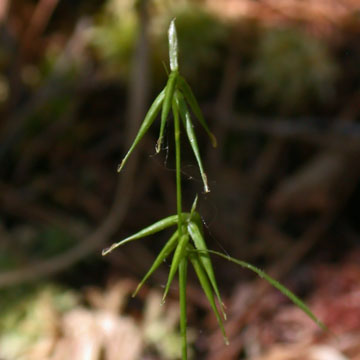

Carex collinsii - (image 1 of 4)
Taxonomy
Family: Cyperaceae
Section Collinsiae
Habitat
Shaded peatlands, primarily Atlantic white cedar swamps but sometimes under black spruce.
Associates
Distribution
Mostly on the coastal plain from RI to GA.
Morphology
Tufted perennial, 20-60 cm; stems surpassing the leaves; main leaves 2-4 mm wide; terminal spike staminate, 5-10 mm, sessile or short-peduncled; pistillate spikes 2-4, separate, erect, pedunculate, usually staminate at the tip, the axis to 1 cm; bracts leaf-like, overtopping the spikes, strongly sheathing at the base; pistillate scales ovate, 3-5 mm, hyaline with green midvein, acute to short-awned, persistent; perigynia green with red-brown spots, 15-20 raised veins, slenderly subulate, 8-12 mm long, nearly circular in cross-section, long-attenuate above, the beak with a long fissure and two conspicuous, abruptly reflexed teeth to 1 mm; achene rounded-trigonous, continuous with the persistent slender style.
Notes
Fruiting July to August
Wetland indicator: OBL
As sedges go this species is pretty easy to identify because of its evenly spaced lateral spikes each with 6-10 long, slender perigynia and the fact that it is usually found growing in the shade of Atlantic white cedars. Carex pauciflora is superficially similar and also grows in peatlands, but only has one spike at the top of the stem (vs. 3-5 spikes per stem) and the perigynia have shorter beaks (2 mm vs. 3-4 mm).
References
Gleason, Henry A. and A. Cronquist. 1991. Manual of Vascular Plants of
Northeastern United States and Adjacent Canada. Second Ed.
The New York Botanical Garden. Bronx, NY
|
© Michael Hough 2018 |